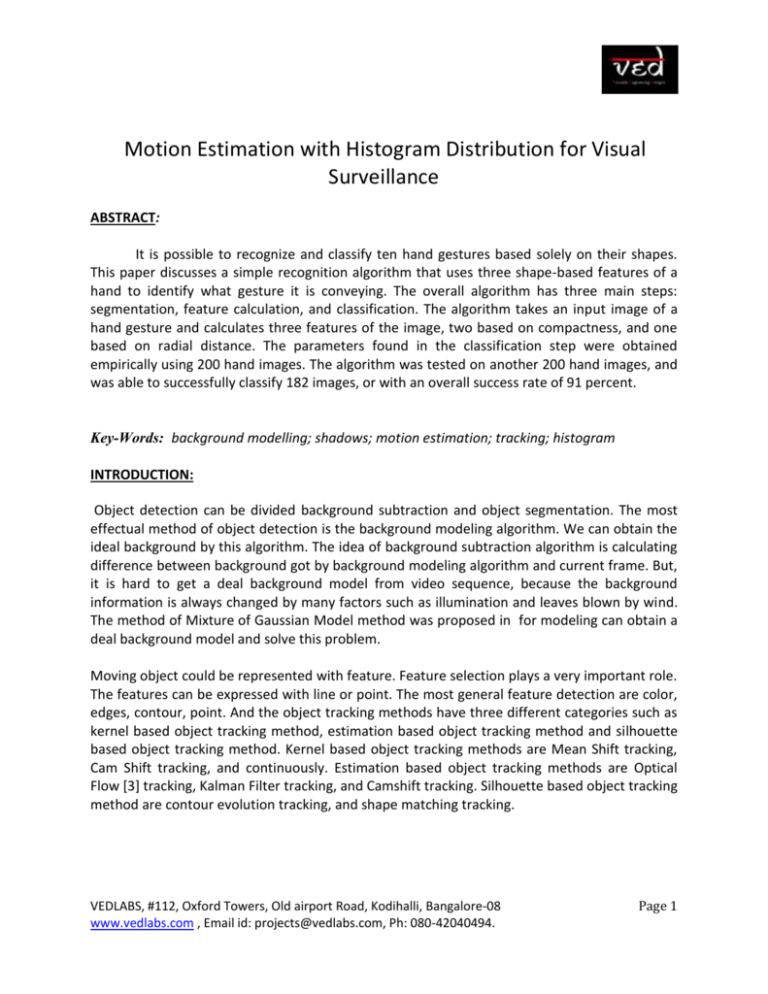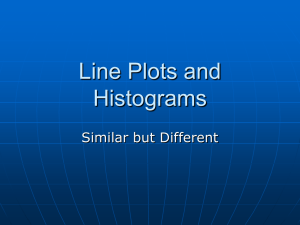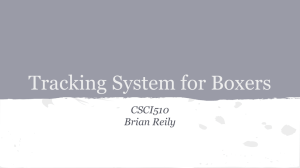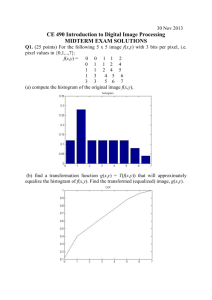Abstract - Best IEEE Projects
advertisement

Motion Estimation with Histogram Distribution for Visual Surveillance ABSTRACT: It is possible to recognize and classify ten hand gestures based solely on their shapes. This paper discusses a simple recognition algorithm that uses three shape-based features of a hand to identify what gesture it is conveying. The overall algorithm has three main steps: segmentation, feature calculation, and classification. The algorithm takes an input image of a hand gesture and calculates three features of the image, two based on compactness, and one based on radial distance. The parameters found in the classification step were obtained empirically using 200 hand images. The algorithm was tested on another 200 hand images, and was able to successfully classify 182 images, or with an overall success rate of 91 percent. Key-Words: background modelling; shadows; motion estimation; tracking; histogram INTRODUCTION: Object detection can be divided background subtraction and object segmentation. The most effectual method of object detection is the background modeling algorithm. We can obtain the ideal background by this algorithm. The idea of background subtraction algorithm is calculating difference between background got by background modeling algorithm and current frame. But, it is hard to get a deal background model from video sequence, because the background information is always changed by many factors such as illumination and leaves blown by wind. The method of Mixture of Gaussian Model method was proposed in for modeling can obtain a deal background model and solve this problem. Moving object could be represented with feature. Feature selection plays a very important role. The features can be expressed with line or point. The most general feature detection are color, edges, contour, point. And the object tracking methods have three different categories such as kernel based object tracking method, estimation based object tracking method and silhouette based object tracking method. Kernel based object tracking methods are Mean Shift tracking, Cam Shift tracking, and continuously. Estimation based object tracking methods are Optical Flow [3] tracking, Kalman Filter tracking, and Camshift tracking. Silhouette based object tracking method are contour evolution tracking, and shape matching tracking. VEDLABS, #112, Oxford Towers, Old airport Road, Kodihalli, Bangalore-08 www.vedlabs.com , Email id: projects@vedlabs.com, Ph: 080-42040494. Page 1 BLOCK DIAGRAM: Figure 1. Flow chart of tracking. our idea of the method proposed is that to incorporate the histogram of object detected and the motion estimated by the Kalman filter method. First, we calculate the previous histogram, and then calculate the back-projection image using this histogram. Before finding the new location of the moving object with Kalman filter, we update the back-projection image using the motion information with histogram. For that, we calculate the global motion of each object, and for each back-projection image calculated using the histogram, we update each point pixels going in the same direction of the object. Doing this, we will be able to follow multi-object crossing, and know who is who when they keep going in two opposite directions. Using this method, we need also to use the first type of the histogram (hue component) because it was difficult to combine information from the 3-D histogram and motion. The flow chart of proposed method is shown in figure 1. HARDWARE AND SOFTWARE REQUIREMENTS: Software Requirement Specification: Operating System: Windows XP with SP2 Tool: MATLAB R2010, Version: 7.10.0 Hardware Requirement specification: Minimum Intel Pentium IV Processor Primary memory: 2 GB RAM, VEDLABS, #112, Oxford Towers, Old airport Road, Kodihalli, Bangalore-08 www.vedlabs.com , Email id: projects@vedlabs.com, Ph: 080-42040494. Page 2 REFERENCES: [1] A. Monnet, A. Mittal, N. Paragios, V. Ramesh, “Background modelling and subtraction of bynamic scene,” Oct. pp. 1305-1312, 2003. [2] C. Stauffer, W.E.L. Grimson, “Adaptive Background Mixture Models for Real-time Tracking,” in Proceedings of IEEE Int’l Conference on Computer Vision and Pattern Recognition, pp. 246252, 1999. [3] Jean-Yves Bouguet, “Pyramidal Implementation of the Lucas Kanade Feature Tracker – Description of the algorithm,” Intel Corporation Microprocessor Research Labs, 2000. [4] Greg Welch, Gary Bishop, “ An introduction to the Kalman filter,” In SIGGRAPG 2001, Los Angeles, CA, August 12-17, 2001. [5] Comaniciu, D., Ramesh, V., Andmeer, p., “Kernel-based object tracking,” IEEE Trans. Patt. Analy. Mach. Intell. 25, pp. 564-575, 2003. VEDLABS, #112, Oxford Towers, Old airport Road, Kodihalli, Bangalore-08 www.vedlabs.com , Email id: projects@vedlabs.com, Ph: 080-42040494. Page 3











